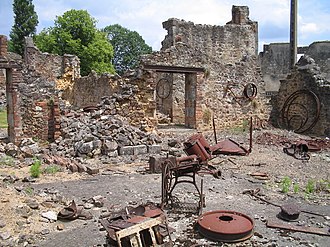and to forget the atrocities of German Imperalism in France and to forget the only real people's revolution nowadays in Europe of yellow vests against German Imperalism in France
https://www.ziemlich-gute-freunde.de/

some examples of how the german state think about France
And the reality
SS killer of French People: I regret nothing
On 10 June 1944, the village of Oradour-sur-Glane in Haute-Vienne in Nazi-occupied France was destroyed when 642 of its inhabitants, including women and children, were massacred by a German Waffen-SScompany.
A new village was built nearby after the war, but President Charles de Gaulle ordered the original maintained as a permanent memorial and museum.
On 10 June, Diekmann's battalion sealed off Oradour-sur-Glane and ordered everyone within to assemble in the village square to have their identity papers examined. This included six non-residents who happened to be bicycling through the village when the SS unit arrived. The women and children were locked in the church, and the village was looted. The men were led to six barns and sheds, where machine guns were already in place.
According to a survivor's account, the SS men then began shooting, aiming for their legs. When victims were unable to move, the SS men covered them with fuel and set the barns on fire. Only six men managed to escape. One of them was later seen walking down a road and was shot dead. In all, 190 Frenchmen died.
The SS men next proceeded to the church and placed an incendiary device beside it. When it was ignited, women and children tried to escape through the doors and windows, only to be met with machine-gun fire. 247 women and 205 children died in the attack. The only survivor was 47-year-old Marguerite Rouffanche. She escaped through a rear sacristy window, followed by a young woman and child.[3] All three were shot, two of them fatally. Rouffanche crawled to some pea bushes and remained hidden overnight until she was found and rescued the next morning. About twenty villagers had fled Oradour-sur-Glane as soon as the SS unit had appeared. That night, the village was partially razed.
Several days later, the survivors were allowed to bury the 642 dead inhabitants of Oradour-sur-Glane who had been killed in just a few hours. Adolf Diekmann said the atrocity was in retaliation for the partisan activity in nearby Tulle and the kidnapping of an SS commander, Helmut Kämpfe.
Murphy report
Raymond J. Murphy, a 20-year-old American B-17 navigator shot down over Avord, France in late April 1944, witnessed the aftermath of the massacre.[4] After being hidden by the French Resistance, Murphy was flown to England on 6 August, and in debriefing filled in a questionnaire on 7 August and made several drafts of a formal report.[4] The version finally submitted on 15 August has a handwritten addendum:[5]
Murphy's report was made public in 2011 after a Freedom of Information Act request by his grandson, an attorney in the United States Department of Justice National Security Division.[4] It is the only account to mention crucifying a baby.[4] Shane Harris concludes the addendum is a true statement by Murphy and that the town, not named in Murphy's report, is very likely Oradour-sur-Glane
Protests at Diekmann's unilateral action followed, both from Field Marshal Erwin Rommel, General Gleiniger, German commander in Limoges, as well as the Vichy Government. Even SS-StandartenführerStadler felt Diekmann had far exceeded his orders and began an investigation. However, Diekmann was killed in action shortly afterwards during the Battle of Normandy; many of the third company, which had conducted the massacre, were also killed in action. The investigation was then suspended.
Postwar trials
On 12 January 1953, a military tribunal in Bordeaux heard the charges against the surviving 65 of the 200 or so SS men who had been involved. Only 21 of them were present, as many were in East Germany, which would not permit their extradition. Seven of those charged were German citizens, but 14 were Alsatians, French nationals whose home region had been annexed by Germany in 1940. All but one of the Alsatians claimed to have been forced to join the Waffen-SS. Such forced conscripts from Alsace and Lorrainecalled themselves the malgré-nous, meaning "against our will".
On 11 February, 20 defendants were found guilty. Continuing uproar in Alsace (including demands for autonomy) pressed the French parliament to pass an amnesty law for all the malgré-nous on 19 February. The convicted Alsatian former SS men were released shortly afterwards, which caused bitter protests in the Limousin region.
By 1958, all of the German defendants had also been released. General Heinz Lammerding of the Das Reich division, who had given the orders for retaliation against the Resistance, died in 1971, following a successful entrepreneurial career. At the time of the trial, he lived in Düsseldorf, in the former British occupation zone of West Germany, and the French government never obtained his extradition from West Germany.[6]
The last trial of a Waffen-SS member who had been involved took place in 1983. Former SS-Obersturmführer Heinz Barth was tracked down in East Germany. Barth had participated in the Oradour-sur-Glane massacre as a platoon leader in the "Der Führer" regiment, commanding 45 SS men. He was one of several charged with giving orders to shoot 20 men in a garage. Barth was sentenced to life imprisonment by the First Senate of the City Court of Berlin. He was released from prison in the reunified Germany in 1997 and died in August 2007.
On 8 January 2014, Werner Christukat,[7] an 88-year-old former member of the 3rd Company of the 1st Battalion of the "Der Führer" SS regiment was charged, by the state court in Cologne, with 25 charges of murder and hundreds of counts of accessory to murder in connection with the massacre in Oradour-sur-Glane.[8] The suspect, who was identified only as Werner C., had until 31 March 2014 to respond to the charges. If the case went to trial, it could have possibly been held in a juvenile court because the suspect was only 19 at the time it occurred. According to his attorney, Rainer Pohlen, the suspect acknowledged being at the village but denied being involved in any killings.[9] On 9 December 2014, the court dropped the case, citing a lack of any witness statements or reliable documentary evidence able to disprove the suspect's contention that he was not a part of the massacre.[10]
Memorial
After the war, General Charles de Gaulledecided the village should never be rebuilt, but would remain a memorial to the cruelty of the Nazi occupation. The new village of Oradour-sur-Glane (population 2,375 in 2012), northwest of the site of the massacre, was built after the war. The ruins of the original village remain as a memorial to the dead and to represent similar sites and events.
In 1999 French president Jacques Chiracdedicated a memorial museum, the Centre de la mémoire d'Oradour, near the entrance to the Village Martyr ("martyred village"). Its museum includes items recovered from the burned-out buildings: watches stopped at the time their owners were burned alive, glasses melted from the intense heat, and various personal items.
On 6 June 2004, at the commemorative ceremony of the Normandy invasion in Caen, German chancellor Gerhard Schröder pledged that Germany would not forget the Nazi atrocities and specifically mentioned Oradour-sur-Glane.
On 4 September 2013, German president Joachim Gauck and French president François Hollande visited the ghost village of Oradour-sur-Glane. A joint news conference broadcast by the two leaders followed their tour of the site.[11] This was the first time a German president had come to the site of one of the biggest World War II massacres on French soil.[11]
On 28 April 2017, Emmanuel Macron, independent presidential candidate, visited Oradour-sur-Glane and met with the only remaining survivor of the massacre, Robert Hébras.[12]
---------------------




















No comments:
Post a Comment